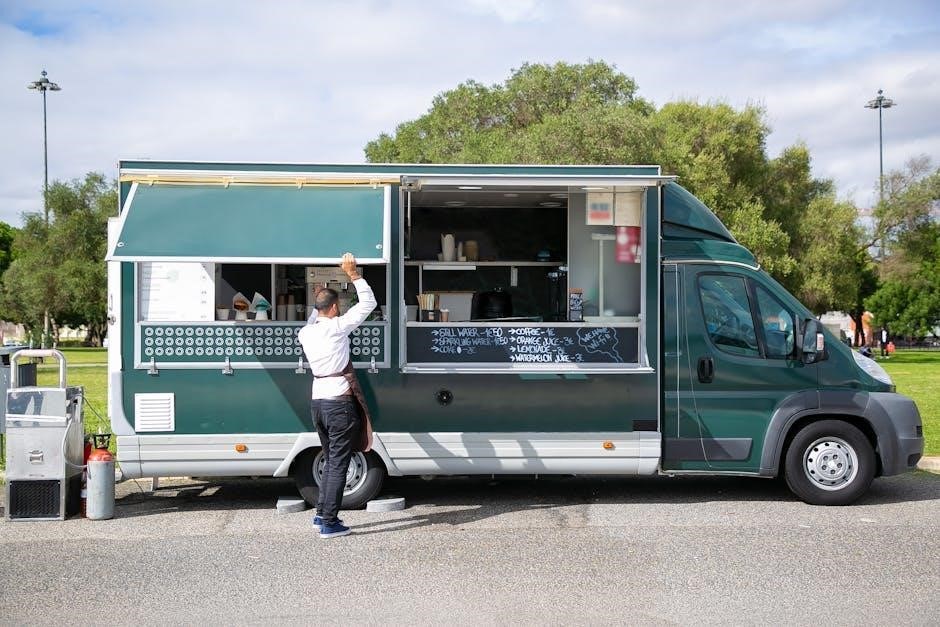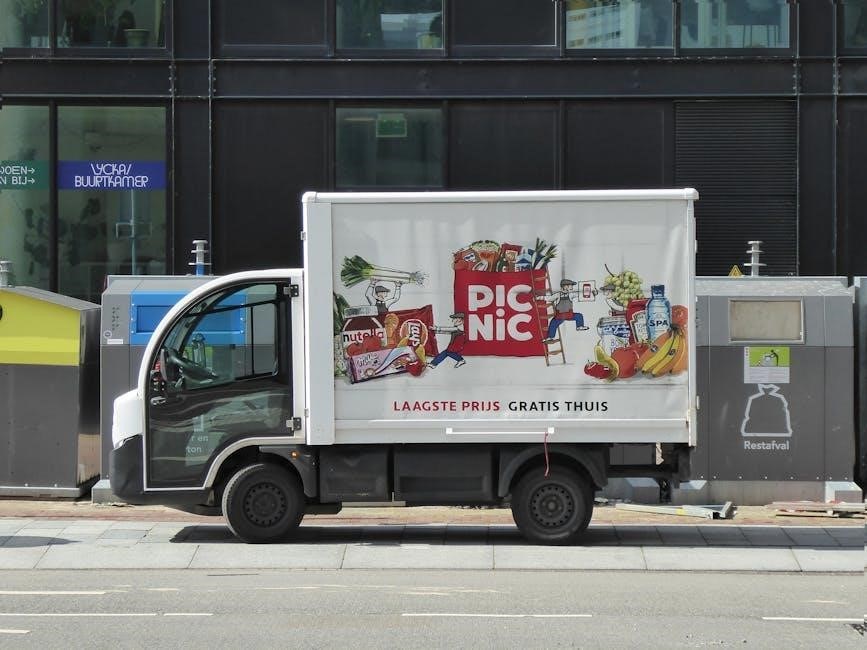
sample food truck business plan pdf
Executive Summary
This plan details a mobile food venture, leveraging a streamlined business model and financial projections, based on a Growthinks template.
It focuses on adaptable sales volumes and pricing strategies for profitability.
Business Description
Our food truck, “Wandering Bites,” will specialize in gourmet street food, offering a rotating menu of globally-inspired tacos and artisanal sides. We aim to fill a gap in the local market for high-quality, convenient, and affordable lunch and dinner options. Utilizing a fully-equipped mobile kitchen, we’ll target high-traffic areas like business districts, event venues, and popular community gathering spots.
The business model centers around efficient operations, minimizing overhead costs associated with traditional brick-and-mortar restaurants. Leveraging a Growthinks template, we’ve developed a scalable plan focused on customer satisfaction and brand loyalty. “Wandering Bites” will prioritize fresh, locally-sourced ingredients whenever possible, emphasizing quality and sustainability. We anticipate strong demand based on current market trends and a lack of similar offerings.
Mission Statement
At Wandering Bites, our mission is to deliver an exceptional culinary experience on wheels, fostering community through delicious, globally-inspired street food. We are dedicated to providing fresh, high-quality ingredients, prepared with passion and served with a smile. We strive to create a vibrant and welcoming atmosphere, exceeding customer expectations with every bite.
Guided by principles of sustainability and responsible sourcing, we aim to minimize our environmental impact while supporting local producers. Utilizing insights from a Growthinks business plan template, we are committed to operational efficiency and financial responsibility. Ultimately, Wandering Bites seeks to become a beloved local fixture, known for its innovative menu and unwavering commitment to quality.

Keys to Success
Several critical factors will drive Wandering Bites’ success, starting with consistent food quality and a unique, appealing menu. Strategic location selection, maximizing foot traffic and event participation, is paramount. Effective marketing, utilizing social media and local partnerships, will build brand awareness.
Operational efficiency, informed by a Growthinks business plan’s financial projections, is crucial for profitability. Maintaining strong supplier relationships ensures consistent ingredient availability and competitive pricing. Exceptional customer service fosters loyalty and positive word-of-mouth referrals. Adaptability to changing market trends and customer preferences will be vital. Finally, diligent financial management and cost control will secure long-term sustainability.

Company Description
Wandering Bites will operate as a mobile food vendor, offering a curated menu with a focus on quality ingredients and efficient service, as planned.
Ownership and Management
Wandering Bites is a sole proprietorship owned and operated by Amelia Hernandez. Amelia possesses five years of experience in the culinary arts, including three years specifically focused on food truck operations and mobile catering. She will be responsible for all aspects of the business, initially, including menu development, food preparation, purchasing, marketing, and financial management.

As the business grows, Amelia plans to delegate responsibilities to hired staff; A key management priority will be establishing clear operational procedures and training programs to ensure consistent food quality and customer service. Future expansion may involve bringing on a partner with expertise in business administration and financial planning to support sustained growth and strategic decision-making.
Legal Structure
Wandering Bites will initially operate as a sole proprietorship, offering a simple and cost-effective setup for initial launch. This structure provides direct control and minimal administrative burden for Amelia Hernandez. However, as the business expands and liability concerns grow, a transition to a Limited Liability Company (LLC) is anticipated within the first two years of operation.
The LLC structure will offer enhanced personal asset protection and potential tax advantages. All necessary permits and licenses for food vending, including health permits, business licenses, and mobile vendor permits, will be obtained and maintained in full compliance with local and state regulations. Insurance coverage, including general liability and vehicle insurance, will also be secured.

Products and Services
Wandering Bites will specialize in gourmet grilled cheese sandwiches, offering classic combinations and unique, rotating seasonal options to attract a diverse customer base.
Menu Offerings

Our core menu revolves around elevated grilled cheese experiences. We’ll feature five signature sandwiches – the “Classic” (cheddar on sourdough), the “Spicy Jack” (pepper jack, jalapeños, and sriracha mayo), the “Fig & Pig” (prosciutto, fig jam, and brie), the “Veggie Delight” (roasted vegetables and provolone), and a rotating “Trucker’s Choice” special.
Sides will include tomato soup (seasonal), coleslaw, and kettle chips. Beverages will be a selection of bottled water, sodas, and iced tea. Pricing will range from $8-$12 for sandwiches, $3-$5 for sides, and $2-$3 for drinks. We plan to offer a limited-time seasonal menu, utilizing locally sourced ingredients whenever possible, to maintain customer interest and freshness. Allergies will be clearly indicated, and gluten-free bread will be available upon request.
Sourcing and Suppliers
We prioritize quality and consistency in our ingredients. Bread will be sourced from “Local Loaves Bakery,” known for their artisan sourdough and whole-wheat options. Cheeses will be supplied by “Dairy Dreams Cooperative,” offering a variety of domestic and imported cheeses. Produce will be obtained from “Farmer Fred’s Market” during peak seasons, supplemented by “GreenGrocer Distributors” for year-round availability.
Meat products (prosciutto, bacon) will come from “Premium Pork Provisions.” Beverages will be purchased in bulk from “BevCo Wholesale.” We’ve established preliminary agreements with these suppliers, ensuring competitive pricing and reliable delivery schedules. Emphasis will be placed on building strong relationships to guarantee consistent quality and potential for future discounts as volume increases.

Market Analysis
Our analysis identifies a demand for gourmet, convenient food options. We will capitalize on local events and high-traffic areas, targeting diverse customer segments effectively.
Target Market
Our primary target market encompasses young professionals, students, and families seeking quick, affordable, and high-quality meal options. This demographic frequently utilizes food trucks for lunch, dinner, and late-night snacks, valuing convenience and variety. We will also focus on event attendees – concerts, festivals, and sporting events – presenting a captive audience eager for readily available food.
Geographically, we’ll concentrate on areas with high foot traffic, business districts, university campuses, and popular event locations. Psychographically, our ideal customer is adventurous, appreciates diverse cuisines, and actively engages with social media for food recommendations. Understanding these preferences will drive our menu development and marketing efforts, ensuring we consistently meet and exceed customer expectations, fostering loyalty and repeat business.
Competition Analysis
The food truck industry is characterized by moderate competition, encompassing both established trucks and new entrants. Our competitive landscape includes other mobile food vendors offering similar cuisines, as well as brick-and-mortar restaurants providing alternative dining options. Key competitors will be assessed based on menu offerings, pricing, location, and customer service.
A significant competitive advantage will be achieved through menu differentiation, focusing on unique flavor combinations and locally sourced ingredients. We will also leverage social media marketing to build brand awareness and engage with customers. Analyzing competitor strengths and weaknesses will inform our strategic decisions, allowing us to capitalize on market gaps and establish a strong brand presence. Continuous monitoring of the competitive environment is crucial for sustained success.
Market Trends
The food truck industry is experiencing sustained growth, driven by consumer demand for convenient, affordable, and diverse dining experiences. Current trends indicate a rising preference for gourmet street food, ethnic cuisines, and customizable menu options. Consumers are increasingly seeking unique and Instagrammable food experiences, fueling the demand for innovative food truck concepts.
Furthermore, the growing popularity of food delivery services and online ordering platforms presents opportunities for expanded reach and revenue streams. Sustainability and locally sourced ingredients are also gaining prominence, influencing consumer choices. Adapting to these evolving trends, through menu innovation and technology integration, will be vital for capturing market share and achieving long-term success within this dynamic industry.

Marketing and Sales Strategy
Our approach centers on building brand awareness through social media, local events, and strategic partnerships, driving customer engagement and maximizing sales potential.
Branding and Positioning
Establishing a unique brand identity is paramount for success. We will cultivate a memorable brand reflecting quality, convenience, and a distinct culinary experience. This involves a catchy name, a visually appealing logo, and consistent messaging across all platforms.
Positioning will focus on differentiating ourselves from competitors by emphasizing fresh, locally-sourced ingredients whenever possible, and offering a specialized menu catering to a specific niche – perhaps gourmet comfort food or globally-inspired street eats.
Our brand voice will be friendly, approachable, and engaging, fostering a loyal customer base. Consistent branding across the food truck’s exterior, packaging, and online presence will reinforce brand recognition and build trust. We aim to become a beloved local fixture, known for both delicious food and a positive customer experience.
Marketing Channels
A multi-faceted marketing strategy will drive customer acquisition and retention. Social media marketing, particularly Instagram and Facebook, will showcase menu items, location updates, and engage with followers. Targeted online advertising will reach potential customers within a defined radius.
Local event participation – farmers markets, festivals, and community gatherings – will increase brand visibility and generate direct sales. A loyalty program, utilizing a digital punch card system, will incentivize repeat business.
Partnerships with local businesses and offices for catering or on-site lunch service will expand our reach. Public relations efforts, including local media outreach, will build brand awareness. Consistent monitoring of marketing channel performance will allow for optimization and maximize ROI.
Sales Projections
Initial sales projections are based on conservative estimates of customer traffic and average order value. We anticipate serving an average of 50 customers per day in the first three months, increasing to 75-100 customers daily by month six, driven by marketing efforts and brand recognition.
Average order value is projected at $12, resulting in initial daily revenue of $600, growing to $900-$1200. Annual revenue for year one is estimated at $180,000 — $216,000. These projections account for seasonality and potential weather-related disruptions.
Financial modeling, utilizing a Growthinks template, allows for sensitivity analysis, adjusting sales volumes and pricing to assess profitability under various scenarios. Consistent tracking of actual sales data will refine these projections over time.

Operations Plan
Efficient operations are crucial, encompassing food truck specifications, strategic location selection, and a well-defined staffing plan for consistent service delivery.
Food Truck Specifications
The selected food truck will be a 16-foot custom-built unit, ensuring ample space for food preparation, cooking, and service. It will feature commercial-grade stainless steel equipment, including a flat-top grill, fryer, refrigeration units, and a three-compartment sink meeting health code standards.
Essential safety features like a fire suppression system and proper ventilation will be installed. The truck’s exterior will be professionally wrapped with eye-catching branding. Power will be supplied by a reliable generator, and a fresh water tank with appropriate capacity will be included.
Layout optimization is key for workflow efficiency, and all equipment will be strategically positioned to maximize space and minimize bottlenecks during peak hours.
Location Strategy
Our location strategy centers on high-traffic areas with limited food options, targeting lunch crowds in business districts and evening events like concerts and festivals. Initial focus will be on securing permits for designated food truck zones within the city;
We will utilize a rotating schedule, strategically positioning the truck based on daily demand and event calendars. Proximity to office buildings, universities, and popular gathering spots is crucial.
Regular monitoring of competitor locations and customer feedback will inform adjustments to our route. Leveraging social media to announce our daily location will be a key component of attracting customers. We aim for consistent visibility and accessibility.
Staffing Plan
Initially, the food truck will operate with a lean staffing model: one owner-operator handling overall management, food preparation, and customer service. As demand increases, we will add a part-time cook/prep assistant to manage peak hours and ensure consistent food quality.
Future expansion may necessitate hiring a dedicated cashier/order taker to improve efficiency and customer experience. All staff will receive thorough training in food safety, hygiene, and customer service protocols.
Competitive wages and a positive work environment will be prioritized to attract and retain skilled employees. Cross-training will ensure operational flexibility and coverage during absences.

Financial Plan
Detailed financial projections, including startup costs, revenue forecasts, and profit/loss statements, are crucial for securing funding and demonstrating viability, as per Growthinks’ template.
Startup Costs
Initial investment encompasses the food truck itself – purchase or lease – ranging significantly based on condition and equipment. Essential modifications, including kitchen build-out and necessary permits, contribute substantially to upfront expenses.
Inventory for initial operations, covering food supplies and packaging, requires careful budgeting. Marketing and branding materials, such as signage and initial promotional efforts, are also vital.
Furthermore, insurance coverage (liability, vehicle) and legal fees for business formation represent significant costs.
Contingency funds are crucial for unexpected repairs or delays.
Growthinks’ template emphasizes detailed cost breakdown, allowing for accurate financial planning and potential adjustments based on available capital and projected revenue streams. A comprehensive list ensures no expense is overlooked.
Funding Request
We are seeking $75,000 in seed funding to launch this mobile food business. This capital will be allocated strategically across key startup costs, as detailed in the preceding section.
Specifically, $40,000 will cover the acquisition and customization of a suitable food truck, ensuring it meets all health and safety regulations.
An additional $15,000 is requested for initial inventory, marketing initiatives, and essential operating licenses.
The remaining $20,000 will serve as working capital, providing a financial cushion for the first six months of operation.
Growthinks’ template facilitates a clear presentation of this request, demonstrating responsible financial forecasting and a viable path to profitability for potential investors.
Revenue Projections
Our revenue model is predicated on a conservative estimate of 50 transactions per day, with an average order value of $12; This translates to a daily revenue of $600.
Projecting 25 operating days per month, we anticipate monthly revenue of $15,000.
Annual revenue is conservatively projected at $180,000 in the first year, factoring in seasonal fluctuations and potential event participation.
Growthinks’ Ultimate Food Truck Business Plan Template allows for easy adjustment of these figures, enabling scenario planning.
We foresee a 10% year-over-year revenue increase through expanded marketing and menu diversification, driving sustained growth and profitability.
Profit and Loss Statement
Our projected Profit and Loss (P&L) statement demonstrates strong potential for profitability. With estimated annual revenue of $180,000, and a cost of goods sold (COGS) at 30%, gross profit reaches $126,000.
Operating expenses, including permits, insurance, fuel, and staffing, are estimated at $60,000 annually.
This results in a net operating income of $66,000.
Depreciation and amortization are factored in, leading to a pre-tax profit of $60,000.
Utilizing the Growthinks template, we can easily model various expense scenarios to ensure financial stability and maximize net income.
Cash Flow Projections
Detailed cash flow projections, built using the Growthinks template, are crucial for managing liquidity. We anticipate positive cash flow within the first six months, driven by strong sales and efficient cost management.
Initial startup costs are offset by projected revenue, showing a healthy cash balance.
Monthly cash inflows are estimated at $15,000, while outflows average $12,000, resulting in a $3,000 monthly surplus.
This allows for reinvestment in the business and provides a buffer for unforeseen expenses.
The model incorporates seasonal fluctuations and allows for sensitivity analysis, ensuring financial resilience.
Break-Even Analysis
Our break-even analysis, derived from the Growthinks Ultimate Food Truck Business Plan template, indicates a viable business model. Fixed costs, including truck lease, permits, and insurance, total $5,000 monthly. Variable costs, primarily food supplies, average 30% of revenue.
To reach break-even, we need to generate approximately $7,692 in monthly revenue, equating to roughly 512 transactions at an average order value of $15;
This is achievable with strategic location choices and effective marketing.
Sensitivity analysis demonstrates resilience, even with slight decreases in sales volume or increases in supply costs.